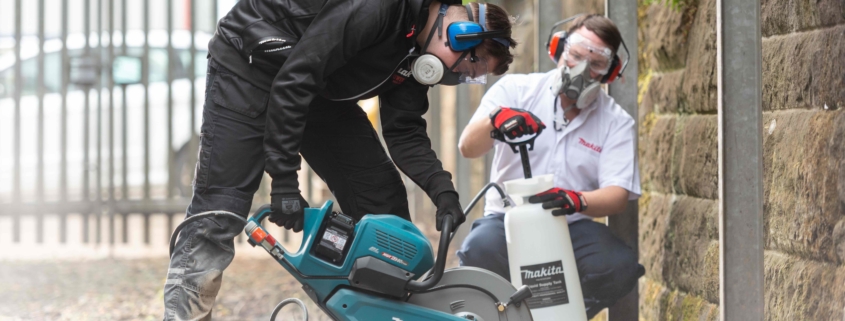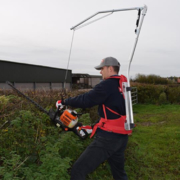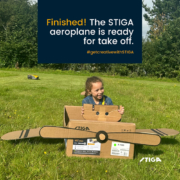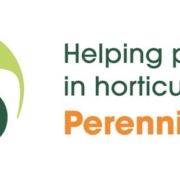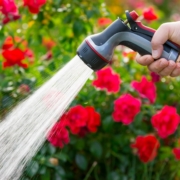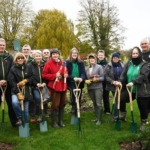Know your tools, stay safe
Whether working in soft or hard landscaping, there are various health and safety measures that professionals should take to minimise risk of injury and harm. Here, Kevin Brannigan, Marketing Manager at Makita, highlights some common risks faced on the job site and how landscapers can protect themselves.
There are numerous potential sources of danger on the job site, including handling harmful chemicals, working at height, trip hazards and working on uneven surfaces, and moving vehicles. Whilst these issues may not occur every day, there is one potentially dangerous activity that poses a risk for the majority of tasks: using power tools. From lawnmowers and hedge trimmers to circular saws and rotary hammers, there is something for every project. Yet no matter how useful such power tools are, it is crucial to be aware of the health and safety implications associated with their use.

Know your tools, stay safe
Vibration
Despite being long overlooked as a normal part of construction, vibration is now a major topic that the power tool industry is working hard to provide solutions for. Specifically, it has become even more prevalent since the EU Physical Agents (Vibration) Directive 2002/44/EC came into force which deals with risks from vibration at work and has been implemented in the UK under the Control of Vibration at Work Regulations 2005.
Prolonged exposure to vibration when using hand-held powered equipment is known to affect blood vessels, nerves, muscles, tendons and other body parts. This can lead to Hand-Arm Vibration (HAV) and, subsequently, Vibration White Finger (VWF), in which surface blood vessels become damaged, resulting in circulatory problems, pain and even gangrene.
Dust
Dust from processes such as drilling, cutting, sanding, grinding, chasing and breaking is a largely unavoidable part of construction, demolition and fabrication work. However, both short and long-term exposure to dust poses a serious risk to health.
Specifically, the Health and Safety Executive (HSE) estimates that as many as 12,000 lung disease-related deaths each year are linked to past exposure to dust. Around 500 of these are a result of exposure to silica dust, the fine particles in brick, cement and masonry dust. Landscapers should also be aware of wood dust, which can contain harmful substances such as bacteria, moulds, or fungi, as well as glues, resins, wood treatment chemicals and formaldehyde.
In more detail, there are two types of dust, the first of which is inhalable. This is made up of visible, airborne particles that are breathed into the airways and deposited in the respiratory tract. And although these particles are usually cleared naturally by the body’s mucus, they can still irritate and damage the skin and eyes.
The second type is respirable dust. This refers to the finer, often invisible particles that can penetrate deep into the lungs. This includes Respirable Crystalline Silica (RCS) that can cause scar tissue to form in the lungs, leading to silicosis. Prolonged exposure to respirable dust can also cause Chronic Obstructive Pulmonary Disease (COPD) which has been linked to cancer.
How to minimise the risk
As awareness continues to spread, manufacturers and employers are increasingly taking measures to provide safer alternatives and create a healthy work environment. This has largely led to the development of new power tool technology that reduces vibration, noise and dust – keeping health risks to a minimum.
Vibration
A significant change has been the use of battery-powered machines which can perform just as well as petrol alternatives whilst offering an array of additional benefits. It is no wonder then that the industry is seeing a shift away from petrol power and a move towards cordless garden machinery products when taking into consideration that today’s leading cordless models provide the power and torque professionals need to tackle many outdoors tasks without emitting fumes that harm both the user and the environment.
The majority of cordless power tools produce lower noise and vibration levels, meaning less disturbance for users and their surroundings. For example, Makita’s Anti-Vibration Technology (AVT) provides a practical combination of high power and low vibration by focusing on dialogue, development and delivery. Additionally, users can also keep track of their exposure to vibration on a daily basis by using Makita’s Vibration Calculator. Aligned to the legal standards defined by the HSE, users simply enter the vibration value of the tool (either manually or from a list of Makita products) and how long they expect for trigger time, and the Makita Vibration Calculator works out the rest, making it easier to prevent HAV and VWF.
Dust
Although dust is unavoidable when sawing and cutting, taking the right safety measures will help prevent serious health complications. The most effective way to control both inhalable and respirable dust is to use an on-tool dust extraction unit that captures it at the source to avoid it becoming airborne. The material being worked on, and therefore the type of dust being produced, will determine whether a L-, M- or H-class extractor is required.
Additionally, there are extractors that automatically activate when the power tool is being used, thus preventing users from opting out of using them for ‘smaller jobs’ as even minute amounts of dust can have a serious impact on health in the long term. For example, cordless tools that feature Makita’s AWS Bluetooth functionality can be connected wirelessly to any M-Class extractor that has a power take-off facility by using one of the Makita wireless adaptor units.
It goes without saying that Personal Protective Equipment (PPE) should be used to further limit exposure. This includes Respiratory Protective Equipment (RPE) such as face-fitting masks as well as gloves and eye protection.
Training
In a recent post we highlighted the importance of training in preventing injury on the job site. As part of its mission to keep users safe, Makita offers the ‘Be Safe’ Grounds Maintenance, Landscaping and Forestry Course which is available on an individual or group basis. The session provides valuable training on best practices, including how to select, handle and store power tools; health and safety risk management; and PPE policies. It also includes a practical element where participants can get hands-on with the tools and acquaint themselves with new product technologies.
To read more about the technology Makita has introduced to improve health and safety, visit: https://makitauk.com/anti-vibration-technology
https://makitauk.com/new-vibration-calculator
For the latest industry news visit landscapingmatters.co.uk/news
Get all of the big headlines, pictures, opinions and videos on stories that matter to you.
Follow us on Twitter and Instagram for fun, fresh and engaging content.
You can also find us on Facebook for more of your must-see news, features, videos and pictures from Landscaping Matters.


